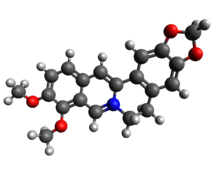Our website is made possible by displaying online advertisements to our visitors.
Please consider supporting us by disabling your ad blocker.
Berberine
 | |
 | |
| Names | |
|---|---|
| IUPAC name
9,10-Dimethoxy-7,8,13,13a-tetradehydro-2′H-[1,3]dioxolo[4′,5′:2,3]berbin-7-ium
| |
| Systematic IUPAC name
9,10-Dimethoxy-5,6-dihydro-2H-7λ5-[1,3]dioxolo[4,5-g]isoquinolino[3,2-a]isoquinolin-7-ylium[2] | |
| Other names | |
| Identifiers | |
3D model (JSmol)
|
|
| 3570374 | |
| ChEBI | |
| ChEMBL | |
| ChemSpider | |
| DrugBank | |
| ECHA InfoCard | 100.016.572 |
| EC Number |
|
| KEGG | |
PubChem CID
|
|
| UNII | |
CompTox Dashboard (EPA)
|
|
| |
| |
| Properties | |
| C20H18NO4+ | |
| Molar mass | 336.366 g·mol−1 |
| Appearance | Yellow solid |
| Melting point | 145 °C (293 °F; 418 K)[3] |
| Slowly soluble[3] | |
Except where otherwise noted, data are given for materials in their standard state (at 25 °C [77 °F], 100 kPa).
| |
Berberine is a quaternary ammonium salt from the protoberberine group of benzylisoquinoline alkaloids, occurring naturally as a secondary metabolite in some plants including species of Berberis, from which its name is derived.
Due to their yellow pigmentation, raw Berberis materials were once commonly used to dye wool, leather, and wood.[4] Under ultraviolet light, berberine shows a strong yellow fluorescence,[5] making it useful in histology for staining heparin in mast cells.[6] As a natural dye, berberine has a color index of 75160.
- ^ a b c The Merck Index, 14th ed., 1154. Berberine
- ^ IUPAC Chemical Nomenclature and Structure Representation Division (2013). "P-73.3.1". In Favre HA, Powell WH (eds.). Nomenclature of Organic Chemistry: IUPAC Recommendations and Preferred Names 2013. IUPAC–RSC. ISBN 978-0-85404-182-4.
- ^ a b The Merck Index, 10th Ed. (1983), p.165, Rahway: Merck & Co.
- ^ Gulrajani ML (2001). "Present status of natural dyes". Indian Journal of Fibre & Textile Research. 26: 191–201. Archived from the original on 2021-11-20. Retrieved 2017-12-28 – via NISCAIR Online Periodicals Repository.
- ^ Weiß D (2008). "Fluoreszenzfarbstoffe in der Natur" (in German). Archived from the original on 9 March 2007. Retrieved 17 July 2009.
- ^ "B3251 Berberine chloride form". Sigma-Aldrich. 2013. Archived from the original on 7 September 2012. Retrieved 2 Aug 2013.
Previous Page Next Page


